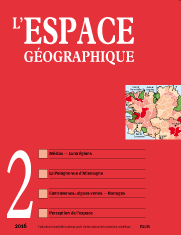

(1 encadré; 2 tabl.)
The discursive construction of Euroregions: Creating a spatial environment by incitement This article considers the discursive construction of territories that are little known by the general public, despite their proliferation since the early 2000s. Using a multi-gender and multilingual corpus relative to the Euroregions, our analysis is based on the postulate that inciting discourse expands and accelerates the construction of cross-border governance and a sense of belonging to the associated territories. The paper focuses on official discourses made by institutions (Euroregions, the European Union, and universities), economic actors, and media. The inventory of discursive markers contributes to establishing the modalities of community incitement in connection with the E.U.’s founding texts, the momentum of border actors traditionally involved in the construction of Europe, and the media’s support for this experimental policy.
keyword: DISCOURSE ANALYSIS, EUROREGION, REGIONALIZATION, TEXTOMETRY
Can football heal old wounds? German media’s portrayal of Poland during the 2012 European championship
In 2012, Poland and Ukraine organized the European football championship. In Germany, where football is highly prominent in the media, newspapers took advantage of the situation to shed new light on Poland. Previously, German press articles on Poland focused mainly on diplomatic relationships, scarred by history and never-ending political controversies. This article shows how a major sporting event can trigger an opportunity for the general press to portray a well-known geographic space beyond traditional points of views and clichés.
keyword: CLICHÉ, FOOTBALL, GERMANY, HISTORY, POLAND, PRESS
A geomedia analysis of international news: Hierarchies and neighbourhood effects (6 fig.)
This paper analyses the international RSS feeds of 37 dailies situated in 16 different States, specifically instances when the States are mentioned. Three aspects were studied: the hierarchy between States, co-occurrences, and finally neighborhood effects. The results demonstrate a high concentration in international news: 20% of States provide a minimum of 80% of mentions for all the newspapers in the corpus. Regardless of the vantage point chosen, the United States occupies a preponderant position. The study of co-occurrences also places the United States at the center, all the while revealing key couples among the States, whether they be cooperative or contentious. Finally, the study of the national sub-corpus reveals specific spatial and editorial logics. Though international news deals primarily with the United States, the second place is given over to neighboring and culturally similar States. Inversely, the State-centrism often cited in previous media studies does not appear to be a systematic rule.
keyword: CENTRE-PERIPHERY, DAILY PRESS, INTERNATIONAL NEWS, RSS FEEDS
Media, green algae, and the Breton agricultural model (3 fig.; 2 tabl.) (annex)
This paper analyses 490 televised news broadcasts featuring Brittany’s “green algae” between 1986 and 2015. The problem has evolved over the past thirty years. It was first depicted as a hindrance to tourism due to urban pollution. It then was classified as an ecological disaster caused by agricultural productivism. Finally, it is currently considered a possible launch pad for sustainable development projects at the territorial level. The media have shaken up the region’s political agenda and in so doing, they have hastened the reassessment of the “Breton agricultural model”.
keyword: AGRICULTURE, BRITAIN, GREEN ALGAE, MEDIA
Temporal and spatial shifts in media narratives on dams (1945-2014) (2 fig.)
This article lays the groundwork for a study on the evolution of discourse about a topical object, the dam. The dam is used here as an indicator to examine how the environment is portrayed. Our research uses the French national daily newspaper, Le Monde, (1945-2014) to develop a francocentered, geo-history of the public perception of dams. Content analysis and textometry are applied to the study of narratives on dams. The periodization of media discourse reveals two temporal shifts (the 1970’s and 1982). Hypotheses on the geographic nuances in the mediatization of large dams are posited. Our research is also based on archives and oral narratives, allowing for a comparison of media versus stakeholders' discourse at key moments when attitudes concerning dams shifted.
keyword: CONTENT ANALYSIS, DAM, MEDIA, PUBLIC PERCEPTION, TEXTOMETRY
The perception of space or a perceptive milieu?
We can only perceive the relations we have established with objects during their passage (the trajection) from information quantitatively available in the general environment (Umgebung) to qualitative signification, allowing them to be perceived as concrete things in a specific milieu (Umwelt).
keyword: AFFORDANCE, ENVIRONMENT, OBJECT, PERCEPTION, REALITY, THING
Book reviews
In this issue of l’Espace géographique, you will find critical reviews of the following books
CRUSE R. (2014). Une géographie populaire de la Caraïbe. Montréal: Mémoire d’encrier, coll. «Essai», 590 p. (Thierry Simon, université de La Réunion) ISBN: 978-2-89712-202-7
RAKOTO RAMIARANTSOA H., BLANC-PAMARD C. (coord.)(2014). Biodiversités en partage. Reconfigurations de ruralités dans le corridor forestier betsileo tanàla (Madagascar). Marseille: IRD Éditions, 264 p. (Frédéric Landy, université Paris Ouest Nanterre) ISBN: 978-2-7099-1832-9
DÉBARRE S. (2014). Géographies entre France et Allemagne. Acteurs, notions et pratiques (fin XIXe siècle-milieu XXe siècle). Paris: CNRS Éditions, coll. «Revue germanique internationale», vol. 20, 212 p. (Laura Péaud, université de Bretagne Sud) ISBN: 978-2-271-08210-7
VERDIER N. (2015). La Carte avant les cartographes. L’avènement du régime cartographique en France au XVIIIe siècle. Paris: Publications de la Sorbonne, 378 p. (François Walter, université de Genève) ISBN: 978-2-85944-888-2
AUGUSTIN J.-P., DUMAS J. (2015). La Ville kaléidoscopique: 50 ans de géographie urbaine francophone. Paris: Anthropos-Economica, 256 p. (Michel Favory, Sciences-Po Bordeaux) ISBN: 978-2-7178-6788-6
REMY J. (2015). L’Espace, un objet central de la sociologie. Toulouse: Érès, 183 p. (Jean-Luc Piermay, Université de Strasbourg, UMR 7363 Sage) ISBN: 978-2-7492-4899-8
REMY J. (2015). L’Espace, un objet central de la sociologie. Toulouse: Érès, 183 p. (Jean-Bernard Racine, université de Lausanne) ISBN: 978-2-7492-4899-8
CLERC P., ROBIC M.-C. (dir.)(2015). Des géographes hors-les-murs? Itinéraires dans un Monde en mouvement (1900-1940). Paris: L’Harmattan, coll. «Histoire des sciences humaines», 400 p. (Claude Bataillon, CNRS Toulouse) ISBN: 978-2-343-07227-2
GAY J.-C. (2014). La Nouvelle-Calédonie. Un destin peu commun. Marseille: IRD Éditions, 238 p. (Benoît Antheaume, IRD Paris) ISBN: 978-2-7099-1748-3
For subscribe or buy this issue: BELIN
![]() L’Espace géographique: contents
L’Espace géographique: contents
Last modified: May 6, 2016